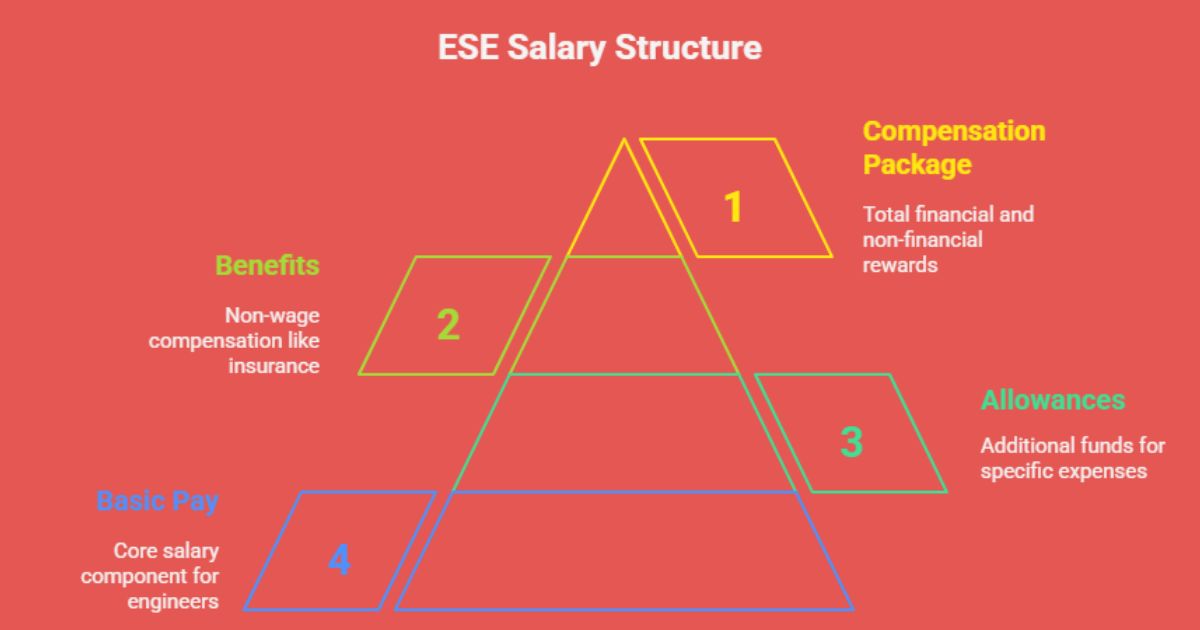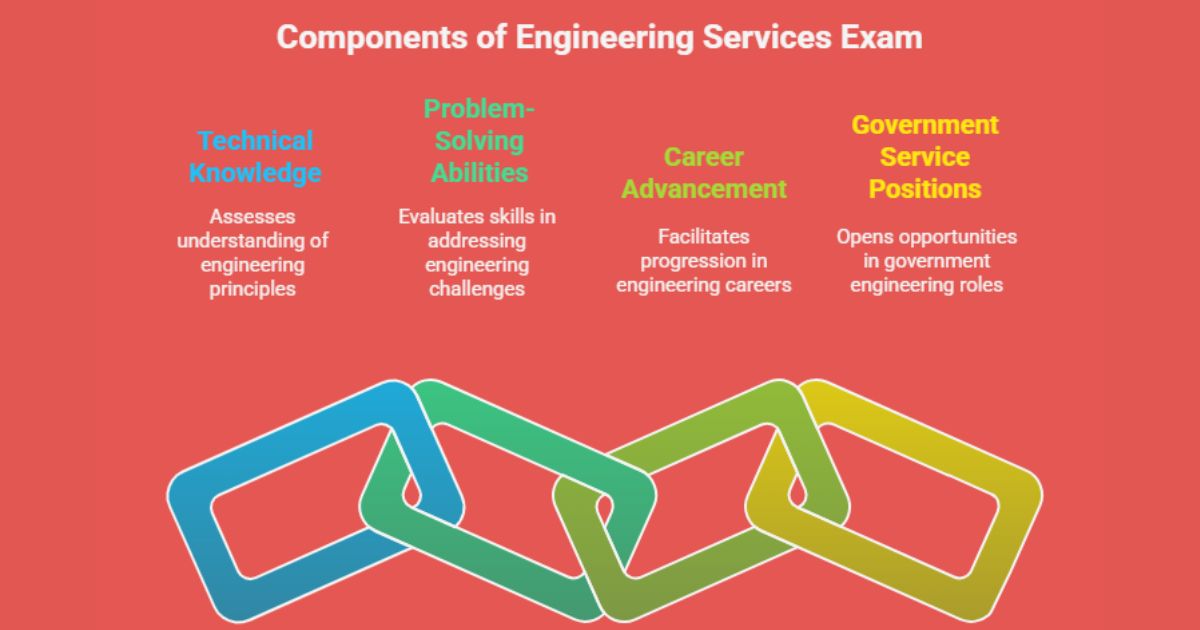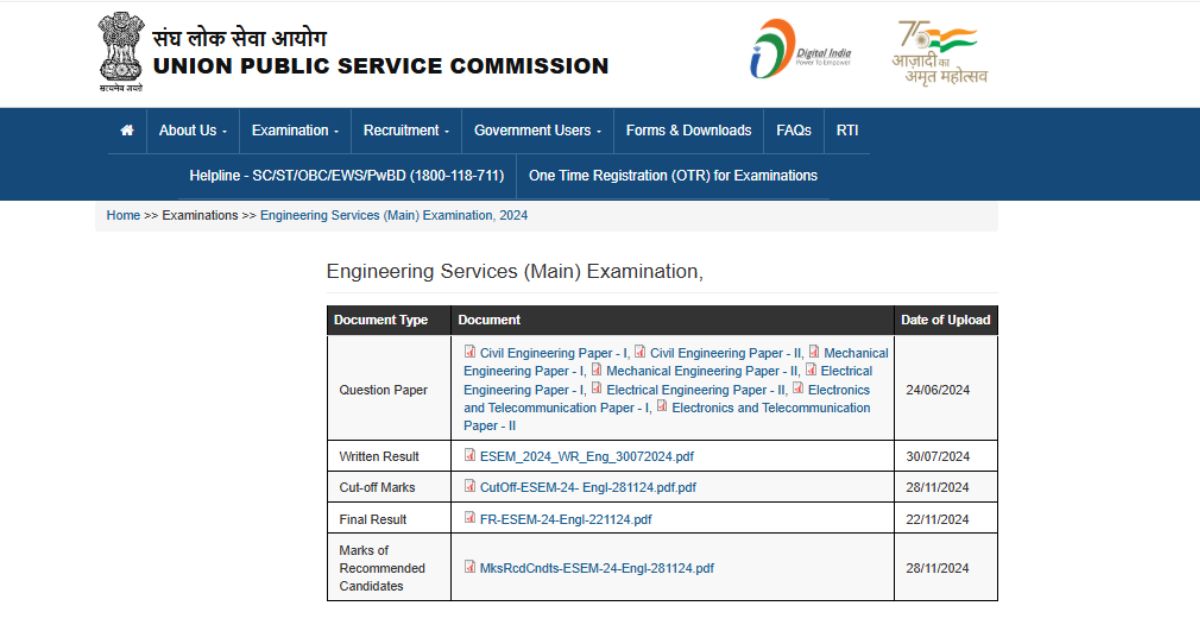The Indian Engineering Services (IES), facilitated through the Engineering Services Main Exam (ESE), stands as the pinnacle of career aspirations for engineering graduates in India.
Conducted annually by the Union Public Service Commission (UPSC), the ESE recruits talented engineers into four key disciplines Civil, Mechanical, Electrical, and Electronics & Telecommunications for critical technical and managerial roles in government sectors.
With the release of the UPSC ESE 2025 notification, a total of 457 vacancies have been announced, comprising 232 for IES positions and 225 for the Indian Railway Management Service (IRMS) through ESE 2025. This presents an unparalleled opportunity for engineers to secure esteemed roles within India’s most coveted government organizations.
The ESE is a rigorous three-stage process involving a Preliminary exam, Mains exam, and a Personality Test. Renowned for its intense competition and limited seats, the ESE is among India’s most prestigious examinations, conferring significant respect and responsibility upon successful candidates, who oversee diverse technical and managerial functions.
As we approach 2025, the UPSC ESE remains a transformative milestone for engineers aiming to shape their careers in public service.
Upon final selection, candidates are appointed as Class-1 Gazetted Officers and assigned to various Ministries and Departments of the Government of India, including Indian Railways, Telecommunications, Border Roads Organisation, Central Public Works Department (CPWD), Central Water Commission (CWC), Central Power Engineering Service (CPES), National Highways Authority of India (NHAI), Naval Armament Service, Indian Defence Service of Engineers (IDSE), Military Engineer Services (MES), and Indian Ordnance Factories, among others.
Additionally, officers may be deployed to any cadre, agency, ministry, department, or Public Sector Undertaking (PSU) under the Government of India, reflecting the dynamic and versatile nature of IES roles.
ESE 2025 Eligibility
To apply for ESE 2025, candidates must meet specific eligibility criteria related to nationality, age, educational qualification, and physical standards.
| Criteria | Details |
| Nationality | Indian citizen, or subject of Nepal/Bhutan, or Tibetan refugee (pre-1962), or Person of Indian Origin from specified countries with intent to settle in India. |
| Age Limit | 21–30 years as of January 1, 2025 (born between January 2, 1995, and January 1, 2004). Age relaxation: SC/ST (5 years), OBC (3 years), PwBD (10 years). |
| Educational Qualification | B.E./B.Tech in Civil, Mechanical, Electrical, or Electronics & Telecommunication Engineering from a recognized university, or equivalent qualifications like AMIE. |
| Physical Standards | Must meet medical standards as per UPSC guidelines (see Section 7). |
Note: Candidates appearing in their final year of qualifying exams are eligible to apply, provided they submit proof of passing by the specified deadline.
Salary Structure After ESE

ESE officers, appointed as Group-A Gazetted Officers, enjoy a lucrative salary package under the 7th Pay Commission, along with perks like HRA, DA, and medical facilities.
| Level | Pay Scale (INR) | In-Hand Salary (Approx., INR) | Allowances |
| Junior Engineer (Entry Level) | 15,600–39,100 (Level 10) | 56,100–1,77,500 | HRA, DA, TA, CGHS, Gratuity, Leave Encashment |
| Senior Engineer (3–5 years) | 67,700–2,08,700 (Level 11) | 80,000–1,20,000 | Same as above, plus official vehicle, PA |
| Junior Administrative Grade | 78,800–2,09,200 (Level 12) | 1,00,000–1,50,000 | Enhanced allowances, residential quarters |
| Senior Administrative Grade | 1,18,500–2,14,100 (Level 14) | 1,50,000–2,00,000 | All perks, higher TA, and pension benefits |
Career Progression: Officers start as Assistant Executive Engineers and can rise to Chairman/Managing Director, with salaries scaling up to INR 2,50,000 at senior levels.
ESE 2025 Exam Pattern
The ESE 2025 comprises three stages: Prelims, Mains, and Personality Test. The Mains is a descriptive exam with two discipline-specific papers.
| Stage | Paper | Marks | Duration | Type |
| Prelims | Paper I: GS & Engg. Aptitude | 200 | 2 hours | Objective |
| Paper II: Discipline-specific | 300 | 3 hours | Objective | |
| Mains | Paper I: Discipline-specific | 300 | 3 hours | Descriptive |
| Paper II: Discipline-specific | 300 | 3 hours | Descriptive | |
| Personality Test | Interview | 200 | 20–30 minutes | Assessment of leadership, personality |
Mains Specifics:
- Each paper has 8 questions; candidates must attempt 5.
- No negative marking, but up to 5% marks may be deducted for illegible handwriting.
- Total Mains marks: 600, critical for final merit.
Importance of ESE Mains
The ESE Mains carries significant weight in the overall selection process, contributing 600 out of the total 1300 marks (500 from Prelims, 600 from Mains, and 200 from the Personality Test). Excelling in the Mains can substantially boost a candidate’s rank and cadre allocation, making it a pivotal stage. The descriptive nature of the exam tests not only technical knowledge but also the ability to articulate answers effectively, manage time, and present solutions systematically.
Why Focus on ESE Mains Preparation?
- Higher Weightage: The Mains accounts for nearly half of the total marks, making it crucial for securing a high rank.
- Subjective Format: Unlike the Prelims, the Mains requires detailed written answers, demanding clarity, structure, and precision.
- Competitive Edge: With only a fraction of Prelims qualifiers advancing to the Mains, thorough preparation can set candidates apart.
ESE 2025 Syllabus
The Mains syllabus is discipline-specific, focusing on advanced topics from Civil, Mechanical, Electrical, or Electronics & Telecommunication Engineering.
| Discipline | Paper I Topics | Paper II Topics |
| Civil Engg. | Building Materials, Solid Mechanics, Structural Analysis, Design of Steel/Concrete Structures | Fluid Mechanics, Hydrology, Environmental Engg., Geotechnical Engg., Transportation Engg. |
| Mechanical Engg. | Fluid Mechanics, Thermodynamics, Heat Transfer, Power Plant Engg. | Mechanics of Materials, Machine Design, Manufacturing, Industrial Engg. |
| Electrical Engg. | Engg. Mathematics, Electric Circuits, Control Systems, Measurements | Power Systems, Electrical Machines, Power Electronics, Microprocessors |
| Electronics & Telecom | Basic Electronics, Analog/Digital Circuits, Network Theory | Communication Systems, Microwave Engg., VLSI, Embedded Systems |
ESE 2025 Preparation Strategy
A structured preparation plan is essential to excel in the descriptive Mains exam. Here’s a step-by-step strategy:
| Aspect | Strategy |
| Syllabus Mastery | Map syllabus to standard books; prioritize high-weightage topics. |
| Answer Writing | Practice 1–2 answers daily; use diagrams, tables, and step-by-step solutions. |
| Previous Year Papers | Solve last 5–10 years’ papers to understand question trends. |
| Mock Tests | Enroll in test series (e.g., MADE EASY, IES Master) for timed practice. |
| Time Management | Allocate 60% time to core subjects, 30% to practice, 10% to revision. |
| Revision | Create concise notes for formulas and diagrams; revise weekly. |
Daily Plan:
- 4 hours: Theory study.
- 2 hours: Numerical practice.
- 1 hour: Answer writing.
- 1 hour: Revision.
ESE 2025 Exam Schedule
The UPSC has released key dates for ESE 2025, with the Mains date to be announced post-Prelims.
| Event | Date |
|---|---|
| Notification Release | September 18, 2024 |
| Application Window | September 18–November 22, 2024 |
| Prelims Exam | February 9, 2025 |
| Mains Exam | August 10, 2025 (Tentative) |
| Personality Test | October–November 2025 (Tentative) |
| Official Application Website | upsconline.nic.in |
Medical Standard for ESE
Candidates must meet UPSC’s medical standards to qualify for ESE posts, assessed post-interview.
| Parameter | Standard |
| Vision | 6/6 or 6/9 with glasses; no color blindness for technical posts. |
| Hearing | No significant hearing impairment; aids allowed for PwBD candidates. |
| Physical Fitness | No chronic diseases (e.g., diabetes, hypertension) that impair duties. |
| Height/Weight | No strict criteria, but proportionate build required. |
Process: Medical tests are conducted at designated government hospitals. PwBD candidates receive accommodations.
ESE 2025 Resources
Quality resources are crucial for effective preparation. Here’s a curated list:
| Resource Type | Recommendations |
| Books | Civil: S.K. Garg (Irrigation); Mechanical: P.K. Nag (Thermodynamics); Electrical: P.S. Bimbhra (Machines); Electronics: Simon Haykin (Communication). |
| Online Platforms | YouTube Channels, Unacademy, Byjus for lectures. |
| Test Series | IES Master, ACE Academy, MADE EASY for Mains-specific mock tests. |
| Previous Year Papers | Download from upsc.gov.in for practice. |
ESE Vacancy 2025 Branch Wise
UPSC has announced 457 vacancies for ESE 2025, including 225 for Indian Railway Management Service (IRMS).
| Discipline | Vacancies (Approx.) |
| Civil Engineering | 180 |
| Mechanical Engineering | 100 |
| Electrical Engineering | 80 |
| Electronics & Telecom | 77 |
| PwBD Reserved | 22 |
ESE Toppers Speak
Toppers emphasize discipline, answer-writing practice, and strategic preparation. Key insights from ESE 2024 toppers include:
- Ankit Kumar (AIR 1, Civil): “Focus on numericals and diagrams; practice writing concise answers daily.”
- Priya Sharma (AIR 3, Mechanical): “Join a test series early to refine answer presentation.”
- Vikram Singh (AIR 5, Electrical): “Revise formulas and high-weightage topics weekly to stay sharp.”
Tip: Watch topper interviews on YouTube channel for motivation and strategies.
ESE 2024 Interview Top Scorer
The ESE 2024 Personality Test saw exceptional performances, with the highest scorer, Rahul Verma (Civil Engineering), securing 190/200 marks. His success was attributed to:
- Clear communication and confidence.
- In-depth knowledge of technical projects and current affairs.
- Mock interview practice with coaching institutes.
ESE 2024 Cutoff Marks
The ESE 2024 cutoffs provide insights into the minimum marks required to qualify.
| Discipline | Prelims Cutoff (500) | Mains + Prelims (1100) | Final Cutoff (1300) |
| Civil Engg. | 230 | 650 | 850 |
| Mechanical Engg. | 220 | 620 | 820 |
| Electrical Engg. | 210 | 600 | 800 |
| Electronics & Telecom | 200 | 580 | 780 |
ESE 2024 Marks of Recommended Candidates
The marks of recommended candidates in ESE 2024 reflect the competitive nature of the exam.
| Rank | Discipline | Prelims (500) | Mains (600) | Interview (200) | Total (1300) |
| AIR 1 | Civil Engg. | 350 | 420 | 180 | 950 |
| AIR 2 | Mechanical Engg. | 340 | 400 | 175 | 915 |
| AIR 3 | Electrical Engg. | 330 | 390 | 170 | 890 |
Insight: High Mains scores (above 400/600) are critical for top ranks.
ESE 2025 Notification

The UPSC ESE 2025 notification, unveiled on September 18, 2024, marks the start of a significant opportunity for engineering graduates aiming for prestigious Indian Engineering Services (IES) roles.
Outlining eligibility criteria, exam structure, and a total of 457 vacancies (232 for IES and 225 for IRMS), the notification sets the stage for a competitive selection process. The application window was open from September 18 to November 22, 2024, with a fee of INR 200, waived for SC/ST, PwBD, and female candidates.
Aspiring engineers applied through www.upsconline.nic.in, and a correction window was available from November 23 to November 29, 2024. For comprehensive details, candidates are advised to download the official notification PDF from www.upsc.gov.in.
ESE 2025 Revised Notification
An addendum to the ESE 2025 notification was issued on October 18, 2024, incorporating 225 IRMS vacancies and extending the application deadline to November 22, 2024. This increased the total vacancies to 457.
IRMS 2025
The Indian Railway Management Service (IRMS) recruitment for 2025 is integrated with ESE 2025, with 225 vacancies across Civil, Mechanical, Electrical, and Signal & Telecommunication branches.
| Branch | Vacancies |
| Civil | 100 |
| Mechanical | 50 |
| Electrical | 40 |
| Signal & Telecom | 35 |
Selection: Based on ESE 2025 performance, followed by document verification.
UPSC Exam Calendar 2025
The UPSC Calendar 2025 outlines key exam dates, including ESE 2025.
| Exam | Notification | Exam Date |
| ESE Prelims | September 18, 2024 | February 9, 2025 |
| ESE Mains | Post-Prelims | August 10, 2025 (Tentative) |
ESE 2024 Top 5 Rankers
The top 5 rankers for ESE 2024, as per the final merit list announced on November 22, 2024, are:
| Rank | Name | Discipline |
| AIR 1 | Rohit Dhondge | Civil Engineering |
| AIR 2 | Harshit Pandey | Civil Engineering |
| AIR 3 | Laxmikant | Civil Engineering |
| AIR 4 | Rajan Kumar | Electrical Engineering |
| AIR 5 | Himanshu Thapliyal | Electronics & Telecom Engineering |
Insight: These candidates excelled due to rigorous preparation, answer-writing practice, and mock interviews.
Contribution of Coaching in ESE Success Stories
Coaching institutes have a proven track record in ESE success, with:
- Over 70% of ESE 2024 selected candidates enrolled in structured programs.
- Comprehensive resources: Workbooks, mock tests, and interview guidance.
- Topper mentorship sessions and online content for accessible preparation.
Example: Coaching programs helped candidates like Ankit Kumar (AIR 1) refine answer-writing skills through test series and faculty feedback.
Tips for Answer Writing in ESE Mains
Answer writing is the cornerstone of ESE Mains success. Here are actionable tips to enhance your answers:
- Read Questions Carefully: Understand the question’s demand (e.g., “explain,” “derive,” “design”). Read each question twice to avoid misinterpretation.
- Plan Before Writing: Spend 1–2 minutes outlining your answer to ensure logical flow.
- Use Technical Terms: Incorporate discipline-specific terminology to demonstrate expertise.
- Support with Examples: Use real-world applications or case studies to enrich answers.
- Avoid Overwriting: Stick to the point and respect word limits to save time.
6.insert diagrams or tables where relevant. For example, in Civil Engineering, include a cross-sectional diagram for a dam design question.
Sample Answer Structure:
- Introduction: Briefly define the concept or context (1–2 sentences).
- Main Body: Explain the concept, solve numerically if required, and include diagrams (3–5 points or steps).
- Conclusion: Summarize key points or provide practical implications (1–2 sentences).
Common Mistakes to Avoid
- Neglecting Answer Writing Practice: Many candidates focus only on theory, leading to poor performance in the descriptive exam.
- Ignoring Previous Year Papers: Not analyzing past papers can result in missing out on recurring topics.
- Poor Time Management: Spending too much time on one question can leave others incomplete.
- Illegible Handwriting: Unclear writing can lead to mark deductions.
- Overcomplicating Answers: Avoid jargon or unnecessary details; simplicity is key.
Conclusion
The UPSC ESE Mains 2025 is a defining stage for aspiring IES officers, demanding technical mastery and polished answer-writing skills. By understanding eligibility, leveraging quality resources, and following a disciplined preparation strategy, candidates can maximize their chances of success. Stay updated with UPSC notifications, practice rigorously, and draw inspiration from toppers’ journeys. With dedication and the right approach, you can secure a prestigious career in the Indian Engineering Services.
For comprehensive preparation tips, past papers, and updates, visit our website at Exam results Live to boost your chances of success.All the best for ESE Mains 2025!
FAQs for UPSC ESE 2025
Q1. What is the eligibility for UPSC ESE 2025?
A. Candidates must be 21–30 years old as of January 1, 2025, with a B.E./B.Tech degree in Civil, Mechanical, Electrical, or Electronics & Telecom Engineering. Age relaxations apply for SC/ST (5 years), OBC (3 years), and PwBD (10 years).
Q2. How many vacancies are there in ESE 2025?
A. There are 457 vacancies, including 232 for IES posts and 225 for IRMS, distributed across Civil (180), Mechanical (100), Electrical (80), and Electronics & Telecom (77) disciplines.
Q3. What is the exam pattern for ESE 2025?
A. The exam has three stages: Prelims (500 marks, objective), Mains (600 marks, descriptive), and Personality Test (200 marks). Prelims includes General Studies & Engineering Aptitude and discipline-specific papers; Mains has two discipline-specific papers.
Q4. How can I apply for UPSC ESE 2025?
A. Applications were accepted at www.upsconline.nic.in from September 18 to November 22, 2024. The correction window was open from November 23 to November 29, 2024.
Q5. What is the syllabus for ESE 2025 Mains?
A. The Mains syllabus is discipline-specific, covering topics like Structural Analysis (Civil), Thermodynamics (Mechanical), Power Systems (Electrical), and Communication Systems (Electronics & Telecom). Detailed syllabus available on upsc.gov.in.
Q6. What is the salary of an IES officer?
A. Entry-level IES officers (Level 10) earn INR 56,100–1,77,500 monthly, with allowances like HRA, DA, and TA. Senior roles (Level 14) can exceed INR 1,50,000, plus perks like quarters and vehicles.
Q7. How to prepare for ESE 2025 Mains?
A. Focus on syllabus coverage, answer-writing practice, and solving previous year papers. Join test series, revise regularly, and use standard books like S.K. Garg (Civil) or P.K. Nag (Mechanical).
Q8. What are the key dates for ESE 2025?
A. Notification: September 18, 2024; Prelims: June 8, 2025; Mains: August 10, 2025 (tentative); Personality Test: October–November 2025 (tentative).
Q9. What is IRMS in ESE 2025?
A. The Indian Railway Management Service (IRMS) recruits 225 officers via ESE 2025 for Civil, Mechanical, Electrical, and Signal & Telecom roles in Indian Railways, integrated with the ESE selection process.
Q10. Where can I find ESE 2025 resources?
A. Use books like P.S. Bimbhra (Electrical), online platforms like Unacademy, and test series from various Academy. Previous year papers are available on upsc.gov.in.
